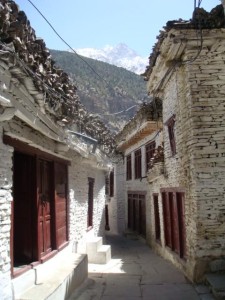It is hard to speak about Mustang [pronounced Moo-staang] without falling into romanticism. Even urban Indians, when confronted with the decrepit homes and children clothed in dirty rags tend to resort to some form of orientalism. A quick online search throws epithets like ‘remote,’ ‘isolated,’ ‘forbidden,’ ‘lost.’ To be sure, Mustang is remote and isolated, cut off from the rest of Nepal by treacherous roads and exhausting rides. Up until 1992, a large part of the region called Upper Mustang was completely closed to all non-Nepalese and entry today requires a special permit. This hermetic existence helped preserve Tibetan Buddhist culture outside Chinese-occupied Tibet but also cut off the area from receiving any benefits of modernisation like basic sanitation, health and education facilities. The Annapurna Circuit and Upper Mustang treks have been steadily opening Mustang to travellers from around the world.
I volunteered for five months as an English and creative lessons teacher at The Marpha Foundation, an NGO in the village of Marpha, wedged in between two high mountains – Nilgiri North (7061 m) and Dhaulagiri (8167 m). While it took me two and a half hours to fly from Mumbai to Kathmandu and about seven on the bus from there to Pokhara, it was only at the end of twelve hours that I reached Marpha. No direct bus being available on the day I travelled, I had to change two buses, one at Beni – a dusty grey transit town – and another at Ghasa. The ride from Beni to Ghasa, running along the Kali Gandaki, was literally bone-shaking, the bus moving more sideways than forwards, and there were instances when it felt that the bus would simply topple into the frothing river. But from Ghasa onward, when each bend along the road opened a new vista onto the snow-capped mountains of the Annapurna Range, the peaks appeared more awesome and beautiful for having gone through that rough ride.
Negotiating the terrain, as I was to discover, was not the only challenge I would face during my time in Marpha. Initially, communicating with the kids was hard as I had no Nepali and the children a small vocabulary and bare grammar in English. The greatest hurdle in communication was in fact my own assumption that urban standards of English would hold true for the grade levels I was teaching. This assumption, I realised, was so ingrained in my brain from interactions with middle-class and upper-middle-class urban kids that it was after some conscious effort that I really became aware of the language I used in the classroom and tempered my lesson objectives accordingly. All the kids I taught in Marpha and in the nearby village of Syang were Hindu Dalits. The other people in Marpha are the self-proclaimed indigenous merchant class known as Thakalis, who follow Tibetan Buddhism. In Marpha, as in the neighbouring villages, the Thakalis own most of the hotels and guest houses along the main street. Their houses, close to or on the main street, are two-storied, with lime-washed stone walls and wood stacked on the terraces and often containing a large patio in the middle of the house. The Dalit houses, often home to livestock like sheep and cows, lie along narrow alleys branching off the main street and along steep paths going up the sandstone hill. These two classes of people live more or less harmoniously but respect the clear boundaries set between them.
Living and working in Marpha, I became acutely aware of the privileges I was born into and which I had taken for granted most of my life. For one, I never had to do my own laundry before then! The children I taught had to work hard – doing chores at the Thakali homes, accompanying their parents to the field, doing chores at their own houses or taking care of the young ones while their parents worked the fields. School and tuition classes like those offered by The Marpha Foundation are therefore often compromised to fulfil more pressing obligations. Regardless of the hardships they bore on a daily basis the children radiated a kind of warmth and trust I had rarely experienced in my teaching career. It was this warmth and the clear mountain air that made all difficulties of living in a village worth the while.
Snehal Vadher




